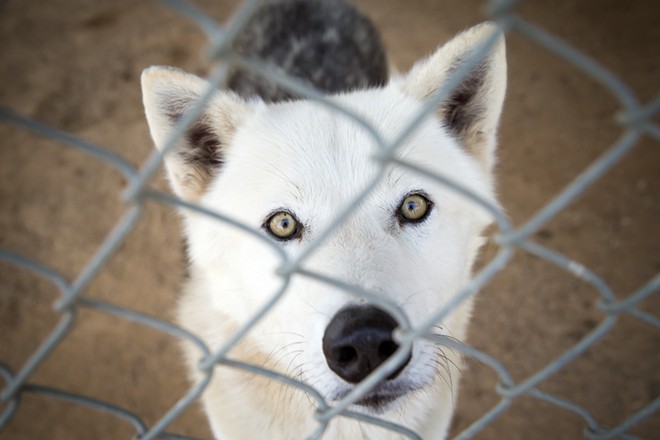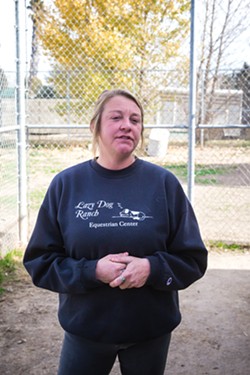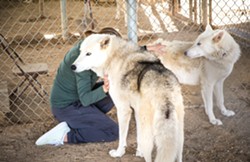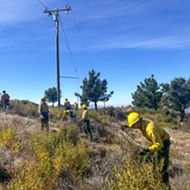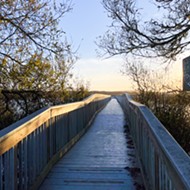Public awareness group Wolf Hybrid Adoption and Rescue is a discreet haven for wolf-dog mixes in Paso Robles
Howl of the hybrid
By Bulbul Rajagopal[{
"name": "Newsletter Promo",
"id": "NewsletterPromo",
"class": "inlineCenter",
"insertPoint": "4",
"component": "15264767",
"requiredCountToDisplay": "0"
},{
"name": "Ad - Medium Rectangle CC01 - 300x250",
"id": "AdMediumRectangleCC01300x250",
"class": "inlineCenter",
"insertPoint": "8",
"component": "2963441",
"requiredCountToDisplay": "12"
},{
"name": "Ad - Medium Rectangle LC01 - 300x250",
"id": "AdMediumRectangleCC01300x250",
"class": "inlineCenter",
"insertPoint": "18",
"component": "2963441",
"requiredCountToDisplay": "22"
},{
"name": "Ad - Medium Rectangle LC09 - 300x250",
"id": "AdMediumRectangleLC09300x250",
"class": "inlineCenter",
"insertPoint": "28",
"component": "3252660",
"requiredCountToDisplay": "32"
}]
Rural Paso Robles is home to the mothballed Paso Robles Juvenile Facility on Airport Road and the Conservation Ambassadors Zoo to You nonprofit on Adobe Road.
But these establishments have unlikely neighbors tucked away from the eyes of the majority of San Luis Obispo County: a pack of wolf hybrids under the watchful care of Wolf Hybrid Adoption and Rescue (WHAR).
Minutes into the walk down a golden vineyard-flanked cul-de-sac off Adobe Road, a pair of wolfish dogs come into view. The large black one paced inside the enclosure, his fluffy tail periodically flicking the chain-link fence.
"All of them are rescues, but it started in 2001 with my mother," said WHAR co-founder and lead trainer Melanie Krutsinger on Dec. 14. "We lost our family dog, and a year later my mom went out searching for a dog, she wanted a rescue, and came across an ad in the paper. ... She found a wolf-dog mix and a full malamute. Before long, my dad started throwing up fencing in the yard."
For more than 20 years, the Krutsingers and their team at WHAR have been a sanctuary for captive-born part- and full-blood wolves. They rescue, rehome, and educate SLO County about wolf hybrid dogs. The six hybrids they now look after—Ragnar, Dahlia, Axle Rose, Soso, Amber, and Dream—are housed in a labyrinth of large fenced and roofed outdoor enclosures. They're all varying degrees of a dog and gray wolf mix.
"It's not like going to the pound and picking up a dog," Krutsinger explained. "There is a lot of merging of households that has to happen. But also understanding the breed. They're not blindly obedient like a dog. They have more questions than a dog."
Krutsinger's mom and dad, Kristi and Mark, set up and operated WHAR on an Estrella Road ranch in Paso Robles until Caltrans acquired the land through eminent domain—the power afforded to governments to take private property for public use and reimburse the owner for its value. Caltrans took over the original WHAR property to widen Highway 46 East.
Conservation Ambassadors extended help to the Krutsingers when local media spread the word about WHAR's plight. The nonprofit leased its Adobe Road land to the wolf hybrid rescue team and even extended the agreement for a few years. By the time Kristi passed away in 2020, WHAR had looked after 16 hybrids—most of whom were elderly.
Back at the Adobe Road sanctuary, the present pack of hybrids are smaller than wolves but share characteristics with their full-blood cousins. Ragnar, a primarily white hybrid with a black star-shaped patch on its back, eagerly approached the front of the enclosure. Jet-black irises punctuated the yellow of his intelligent eyes. A long snout with black whiskers and pointy ears underscored his wolfish features. Ragnar frequently rubbed the length of his lean body along the chain-link fencing, emitting a subtle musk in the process. It's how he spreads his scent and sniffs out others' perfumes.
"We don't normally DNA test any of our animals," Krutsinger said. "We do behavioral assessments to try to gauge where they might be at, but also [study] facial features. Low content wolf dogs will have dog-like features, high content will have wolf-like features."
Ragnar and his enclosure mate Dahlia—a pink-nosed hybrid—"head up education" for WHAR, according to Krutsinger. That means they'll be the sanctuary's ambassadors when Krutsinger takes them into schools for educational programs. The COVID-19 shutdowns forced WHAR into a hiatus from such events, but Krutsinger and the wolf hybrids are ready to be more social again.
"We want to talk to kids about wolf dogs, what they are, and also how important the wolf is for the ecosystem," she said. "It's really needed and wanted on the Central Coast because a lot of our people here are drawn to Nordic breeds like Huskies and malamutes. Sometimes they have a little bit of wolf in them."
Knowing the makeup and temperament of Nordic breeds is crucial. She occasionally gets calls from people who purchase dogs from that line and are perplexed by their behavior. Often, those dogs' unexpected actions are a result of them being part wolf.
"I wanted them to have that research or that resource to be able to contact us, and we can network and help them better understand [the dogs] rather than have them end up in a pound," Krutsinger said.
She added that most animal pounds can't handle hybrids because they're overwhelmed with dogs as it is, leading to the hybrids being put down.
"I'm like, 'It probably could have taken you three weeks of your undivided attention that could have helped you understand your animal a little bit better,'" Krutsinger said.
Equating housing a wolf hybrid to "adopting a 7-year-old child," she said that the ideal owner is patient, doesn't live in an apartment, and has a spacious backyard. Essentially, owning land for the wolf hybrids to settle into doesn't hurt.
Diligence on the owner's part is key. Krutsinger pointed to the midnight-colored hybrid Soso.
"She can actually clear 12-foot fencing; she's got legs for days," Krutsinger said. "She challenged it when she first got here. But after she adjusted, we made adjustments for her, and then she finally settled in. Now she's never challenged it again."
Ragnar, too, can jump fencing, but Krutsinger said he would never go over it unless something stimulated him to try to clear those boundaries.
"But for the most part, if you do your part to understand them as animals, then they'll be content and they'll have no reason to challenge those things," she said.
WHAR's long-running lease with Conservation Ambassadors came to an end in December 2023. In January, the rescue group was in the process of relocating to another winery-ranch property in the Paso Robles area that wished to remain anonymous. The new space will allow a limited number of people for the first few weeks so that the wolf hybrids can adjust to the changed environment.
The move is a costly one for the sanctuary, especially when it comes to constructing new enclosures for the hybrids. While WHAR is actively trying to place some of the hybrids in new homes, it's also looking for donations in the forms of money, physical labor, and kibble and/or raw meat (it prefers lamb, chicken, beef, and even rice). Financial donations can be made to givebutter.com/wharwolves to help WHAR meet its $15,000 goal. To offer other kinds of help, call (805) 400-7473.
Going forward, Krutsinger and her team are dedicated to improving the quality of wolf-dog hybrid lives. She said that a common misconception is that they're vicious creatures.
"In the wrong hands, they can be very dangerous. In the right hands, you can have an amazing relationship with this animal," Krutsinger said. "Anybody who is interested: do your research. You owe it to them, really. I guarantee you, they'll probably teach you more about yourself than you ever knew."

